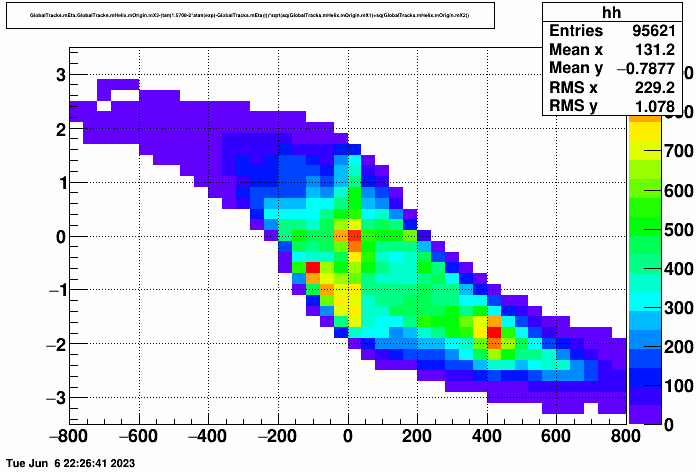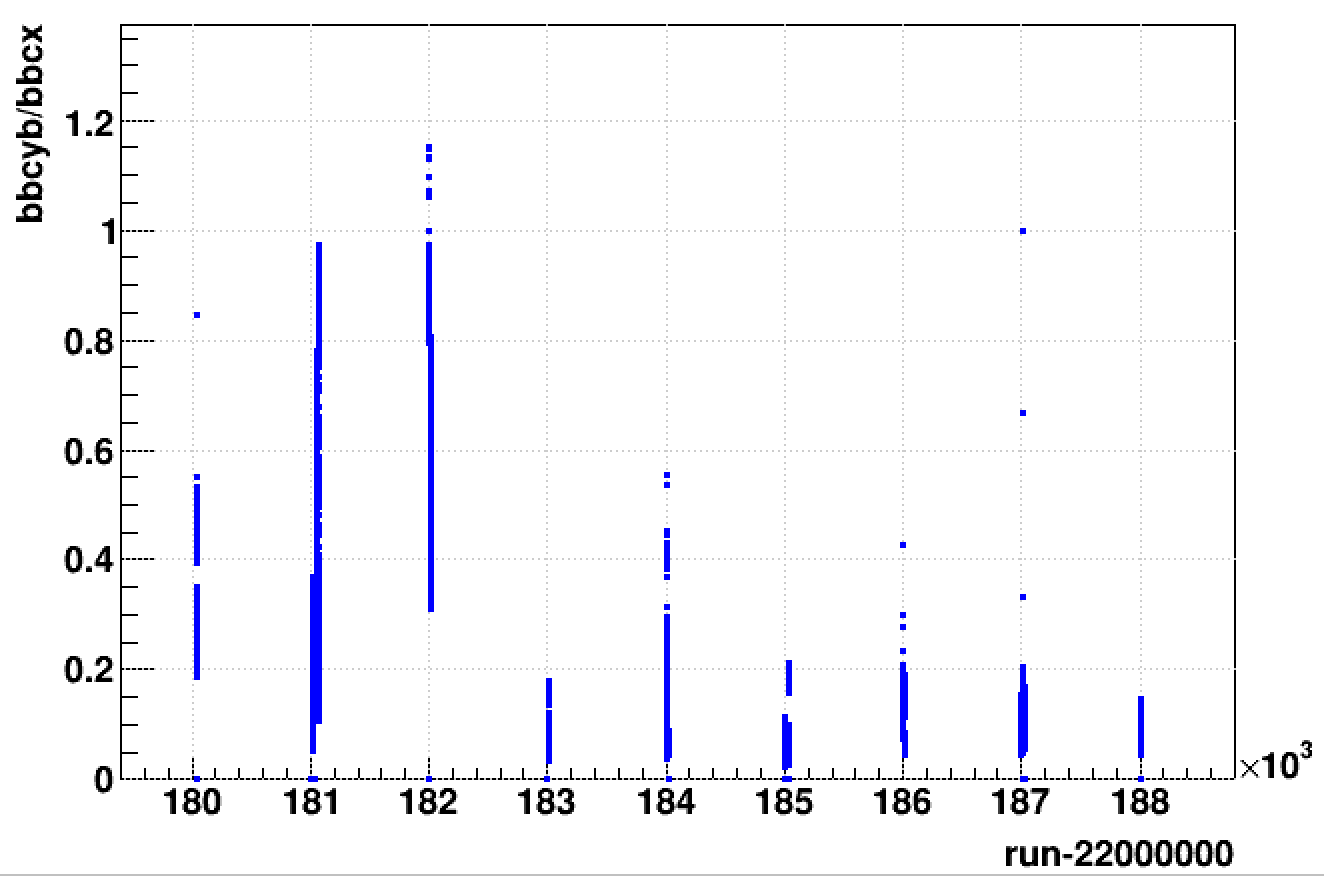- genevb's home page
- Posts
- 2025
- 2024
- 2023
- 2022
- September (1)
- 2021
- 2020
- 2019
- 2018
- 2017
- December (1)
- October (3)
- September (1)
- August (1)
- July (2)
- June (2)
- April (2)
- March (2)
- February (1)
- 2016
- November (2)
- September (1)
- August (2)
- July (1)
- June (2)
- May (2)
- April (1)
- March (5)
- February (2)
- January (1)
- 2015
- December (1)
- October (1)
- September (2)
- June (1)
- May (2)
- April (2)
- March (3)
- February (1)
- January (3)
- 2014
- 2013
- 2012
- 2011
- January (3)
- 2010
- February (4)
- 2009
- 2008
- 2005
- October (1)
- My blog
- Post new blog entry
- All blogs
Investigating symmetry of Run 21 dAu200 SpaceCharge
Updated on Thu, 2023-06-08 11:07. Originally created by genevb on 2023-06-08 10:31.
Babu Pokhrel's efforts to calibrate the SpaceCharge in Run 21 dAu200 data have continually shown a preference towards no east/west asymmetry (and in some cases more on west than east), counter to results from past dAu calibrations and simulations which have pointed to something like 20% asymmetry. I spent some time investigating this, and my conclusions are as follows:
Below are some supporting plots...
These two plots show, for all global tracks (no cuts) from runs 22180044 (left) and 22187002 (right), the pseudorapidity (eta) vs. a simplistic projection to the z axis: zfirst point - radiusfirst point * (pz/pT)
The "+" in the middle is formed by both triggered and pile-up beam-beam collisions (the latter giving an overlap in the central couple z bins from post-crossing tracks). Runs from days 183-188 typically look clean, of upstream tracks, like the plot on the right. Runs from days 180-182 generally show the prominent feature at z = ~ +400 cm as seen in the plot on the left. I have yet to understand the additional feature in the lower left of the plot on the left.


In the plot on the left below is shown the SpaceCharge magnitude (as determined from track signed DCAs) measured separately in the east half of the TPC divided by that from the west half for about 50 runs. These come as available quantities in the calibration procedures. Symmetric SpaceCharge should give a ratio of 1.0, and we can see that for runs with high BBC yellow beam background to BBC coincidence ratios that the observed SpaceCharge is at or even below 1.0, while at low ratios the SpaceCharge is higher as we had originally expected from just the dAu collisions.
The plot below on the right shows that these high scaler ratios generally occurred on days 180-182.


-Gene
- For days 180-182, there is a huge background of particles originating at approximately +400 cm in z that can be seen in global tracks reconstructed in the TPC, which is much reduced for days 183-188.
- Dan Cebra notes that there are flanges at +/-4.02 m in z where the beampipe narrows in diameter from 5 inches to 3 inches.
- J.H. Lee notes that the collider was delivering beam with a crossing angle at STAR for the first few days of dAu running, and that after complaining about backgrounds in STAR, the crossing angle was removed and triggering was restricted to a smaller region of z.
- I postulate that this alternate geometry of particle tracks in the TPC could have two effects:
- These tracks being more parallel to the z axis (higher pseudorapidity) means they contribute more similarly to both east and west. This by itself would unlikely erase all asymmetry.
- Because the ionized charge from these tracks is distributed differently in the radial direction than charge from beam-beam collisions, the relationship between the charge and the signed DCA is different. The distributions being different on east and west because these tracks are not exactly parallel to the z axis means that the relationship between the charge and signed DCA is different between the east and west halves as well, and could potentially lead to similar (symmetric) signed DCAs despite there actually being more charge on one side than the other. Trying to understand this would require simulating various charge distributions (like we did for the FXT SpaceCharge work, but using a target at +402 cm).
- The fact that Babu's calibration primarily finds the BBC west singles rate scaler ("bbcw") to have the best correlation with SpaceCharge fits with the theory that the SpaceCharge is composed of two contributions: a collision contribution (perhaps best correlated with BBC coincidences, "bbcx") and a background contribution (perhaps best correlated with the BBC yellow beam background, "bbcyb"), with bbcw containing contributions from both.
- We have no capability in the SpaceCharge distortion correction code to account for two separate SpaceCharge sources (collisions + backgrounds). While it would be possible to introduce a new charge distribution model (as we have done recently for FXT SpaceCharge), allowing for different magnitudes of charge for the two components to not strictly scale with each other implies additional machinery that does not exist and would require much effort to implement (many new codes, new database tables).<.li>
- My proposal for advancing the calibration without several more weeks (months?) of effort to account for this background is to calibrate the days 180-182 data and days 183-188 data separately, such that they can each have their own degree of east-west asymmetry. This only accounts for the background's charge distribution at the sDCA level, and is unlikely accurate for correcting the particle momenta.
Below are some supporting plots...
These two plots show, for all global tracks (no cuts) from runs 22180044 (left) and 22187002 (right), the pseudorapidity (eta) vs. a simplistic projection to the z axis: zfirst point - radiusfirst point * (pz/pT)
The "+" in the middle is formed by both triggered and pile-up beam-beam collisions (the latter giving an overlap in the central couple z bins from post-crossing tracks). Runs from days 183-188 typically look clean, of upstream tracks, like the plot on the right. Runs from days 180-182 generally show the prominent feature at z = ~ +400 cm as seen in the plot on the left. I have yet to understand the additional feature in the lower left of the plot on the left.


In the plot on the left below is shown the SpaceCharge magnitude (as determined from track signed DCAs) measured separately in the east half of the TPC divided by that from the west half for about 50 runs. These come as available quantities in the calibration procedures. Symmetric SpaceCharge should give a ratio of 1.0, and we can see that for runs with high BBC yellow beam background to BBC coincidence ratios that the observed SpaceCharge is at or even below 1.0, while at low ratios the SpaceCharge is higher as we had originally expected from just the dAu collisions.
The plot below on the right shows that these high scaler ratios generally occurred on days 180-182.


-Gene
»
- genevb's blog
- Login or register to post comments
